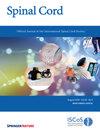Evaluating therapeutic effects of exoskeletons and FES in SCI: integrative review of the literature
IF 2.2
4区 医学
Q3 CLINICAL NEUROLOGY
引用次数: 0
Abstract
Functional electrical stimulation and exoskeletons provide direct functional ability but may also have therapeutic effects that improve function when they are turned off or removed. This integrative review aimed to identify functional clinical outcome assessments used to assess therapeutic effects in rehabilitation technologies for persons with spinal cord injuries, to examine the National Institute of Neurological Disorders and Stroke Common Data Elements recommendation level for SCI for each COA, and determine which COAs distinguish between recovery of function and function from compensation. A literature search identified interventional SCI studies using FES and exoskeletons (n = 1006). Text screens resulted in a sample (n = 56) organized by level of evidence, COAs with their measurement properties, type of intervention with involved limbs, the NINDS CDE recommendation level, and if the COAs distinguished recovery from compensation. 56 articles met inclusion criteria. 31 studies involved exoskeletons, 23 studies involved FES, and 2 studies involved both FES and exoskeleton. Within those 56 articles, 38 COAs were identified across all studies, including different versions of the same COA as separate measures. Of these 38 COAs, 24 were PerfOs and 7 were PROs. The most used COAs did not differentiate recovery from compensation. However, 3 COAs were identified as able to discriminate recovery from compensation. Studies on FES and exoskeletons in SCI have precedent to examine therapeutic effects using a variety of functional COAs. Clinical trials in SCI would benefit from COAs with interval scales that assess therapeutic effects that differentiate between recovery and compensation.

评估外骨骼和FES治疗SCI的效果:文献综合综述。
背景:功能性电刺激和外骨骼提供直接的功能能力,但当它们被关闭或移除时,也可能具有改善功能的治疗效果。目的:本综合综述旨在确定用于评估脊髓损伤患者康复技术治疗效果的功能临床结果评估,检查国家神经疾病和卒中研究所对每种COA的SCI通用数据元素推荐水平,并确定哪些COA区分功能恢复和代偿功能。方法:文献检索确定了使用FES和外骨骼的介入性SCI研究(n = 1006)。文本筛选产生了一个样本(n = 56),按证据水平、coa及其测量特性、涉及肢体的干预类型、NINDS CDE推荐水平以及coa是否区分了恢复和补偿。结果:56篇文章符合纳入标准。31项研究涉及外骨骼,23项研究涉及FES, 2项研究同时涉及FES和外骨骼。在这56篇文章中,在所有研究中确定了38个COA,包括作为单独测量的相同COA的不同版本。在这38个coa中,24个是perfo, 7个是pro。最常用的coa没有区分恢复和补偿。然而,确定了3个coa能够区分恢复和补偿。结论:对脊髓损伤的FES和外骨骼的研究有使用多种功能性coa来检测治疗效果的先例。脊髓损伤的临床试验将受益于具有间隔量表的coa,以评估区分恢复和补偿的治疗效果。
本文章由计算机程序翻译,如有差异,请以英文原文为准。
求助全文
约1分钟内获得全文
求助全文
来源期刊

Spinal cord
医学-临床神经学
CiteScore
4.50
自引率
9.10%
发文量
142
审稿时长
2 months
期刊介绍:
Spinal Cord is a specialised, international journal that has been publishing spinal cord related manuscripts since 1963. It appears monthly, online and in print, and accepts contributions on spinal cord anatomy, physiology, management of injury and disease, and the quality of life and life circumstances of people with a spinal cord injury. Spinal Cord is multi-disciplinary and publishes contributions across the entire spectrum of research ranging from basic science to applied clinical research. It focuses on high quality original research, systematic reviews and narrative reviews.
Spinal Cord''s sister journal Spinal Cord Series and Cases: Clinical Management in Spinal Cord Disorders publishes high quality case reports, small case series, pilot and retrospective studies perspectives, Pulse survey articles, Point-couterpoint articles, correspondences and book reviews. It specialises in material that addresses all aspects of life for persons with spinal cord injuries or disorders. For more information, please see the aims and scope of Spinal Cord Series and Cases.
 求助内容:
求助内容: 应助结果提醒方式:
应助结果提醒方式:


